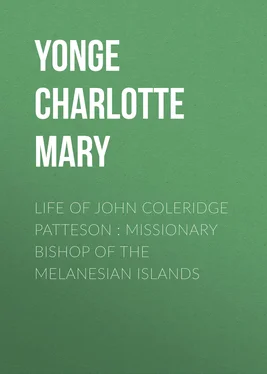Charlotte Yonge - Life of John Coleridge Patteson - Missionary Bishop of the Melanesian Islands
Здесь есть возможность читать онлайн «Charlotte Yonge - Life of John Coleridge Patteson - Missionary Bishop of the Melanesian Islands» — ознакомительный отрывок электронной книги совершенно бесплатно, а после прочтения отрывка купить полную версию. В некоторых случаях можно слушать аудио, скачать через торрент в формате fb2 и присутствует краткое содержание. Жанр: foreign_prose, literature_19, Европейская старинная литература, foreign_antique, на английском языке. Описание произведения, (предисловие) а так же отзывы посетителей доступны на портале библиотеки ЛибКат.
- Название:Life of John Coleridge Patteson : Missionary Bishop of the Melanesian Islands
- Автор:
- Жанр:
- Год:неизвестен
- ISBN:нет данных
- Рейтинг книги:3 / 5. Голосов: 1
-
Избранное:Добавить в избранное
- Отзывы:
-
Ваша оценка:
- 60
- 1
- 2
- 3
- 4
- 5
Life of John Coleridge Patteson : Missionary Bishop of the Melanesian Islands: краткое содержание, описание и аннотация
Предлагаем к чтению аннотацию, описание, краткое содержание или предисловие (зависит от того, что написал сам автор книги «Life of John Coleridge Patteson : Missionary Bishop of the Melanesian Islands»). Если вы не нашли необходимую информацию о книге — напишите в комментариях, мы постараемся отыскать её.
Life of John Coleridge Patteson : Missionary Bishop of the Melanesian Islands — читать онлайн ознакомительный отрывок
Ниже представлен текст книги, разбитый по страницам. Система сохранения места последней прочитанной страницы, позволяет с удобством читать онлайн бесплатно книгу «Life of John Coleridge Patteson : Missionary Bishop of the Melanesian Islands», без необходимости каждый раз заново искать на чём Вы остановились. Поставьте закладку, и сможете в любой момент перейти на страницу, на которой закончили чтение.
Интервал:
Закладка:
All this came to the knowledge of the Bishop of New Zealand while he was occupied with the cares of his first seven years in his more immediate diocese, and in 1848, he made a voyage of inspection in H.M.S. 'Dido.' He then perceived that to attempt the conversion of this host of isles of tropical climate through a resident English clergyman in each, would be impossible, besides which he knew that no Church takes root without native clergy, and he therefore intended bringing boys to New Zealand, and there educating them to become teachers to their countrymen. He had lately established, near Auckland, for the sons of the colonists, St. John's College, which in 1850 was placed under the Reverend Charles John Abraham, the former Eton master, who had joined the Bishop to act as Archdeacon and assist in the scheme of education; and here it was planned that the young Melanesians should be trained.
The Bishop possessed a little schooner of twenty-two tons, the 'Undine,' in which he was accustomed to make his expeditions along the coast; and in August 1849, he set forth in her, with a crew of four, without a weapon of any sort, to 'launch out into the deep, and let down his nets for a draught.' Captain Erskine of H.M.S. 'Havannah' readily undertook to afford him any assistance practicable, and they were to cruise in company, the 'Undine' serving as a pilot boat or tender on coasts where the only guide was 'a few rough sketches collected from small trading vessels.'
They met near Tanna, but not before the Bishop had been in Dillon's Bay, on the island of Erromango, the scene of Williams's murder, and had allowed some of the natives to come on board his vessel as a first step towards friendly intercourse. The plan agreed on by the Bishop and the Captain was to go as far north as Vate, and return by way of the Loyalty Isles, which fringe the east coast of New Caledonia, to touch at that large island, and then visit the Island of Pines, at its extreme south point, and there enquire into a massacre said to have taken place. This was effected, and in each place the natives showed themselves friendly. From New Caledonia the Bishop brought away a pupil named Dallup, and at two of the Loyalty Islands, Nengone or Mare, and Lifu, where Samoan teachers had excited a great desire for farther instruction, boys eagerly begged to go with him, and two were taken from each, in especial Siapo, a young Nengone chief eighteen or nineteen years old, of very pleasing aspect, and with those dignified princely manners which rank is almost sure to give. The first thing done with such lads when they came on board was to make clothes for them, and when they saw the needle employed in their service, they were almost sure to beg to be taught the art, and most of them soon became wonderfully dexterous in it.
On the Island of Pines, so called from the tower-like masses of the Norfolk pine on the shores, was at that time the French Bishop of New Caledonia, the Oul, as the natives called him and his countrymen, for whom they had little love. After an interview between the two bishops, the 'Undine' returned to New Zealand, where the native boys were brought to St. John's College. The system of education there combined agricultural labour and printing with study, and the authorities and the boys shared according to their strength in both, for there was nothing more prominent in the Bishop's plan than that the coloured man was not to be treated as a mere hewer of wood and drawer of water, but, as a Maori once expressed the idea: 'Gentleman—gentleman thought nothing that ought to be done at all too mean for him; pig-gentleman never worked.' The whole community, including the ladies and their guests, dined together in hall.
The five boys behaved well, Siapo being a leader in all that was good, and made advances in Christian knowledge; but it was one of the Bishop's principles that none of them should be baptized till he had proved whether his faith were strong enough to resist the trial of a return to his native home and heathen friends. The climate of New Zealand is far too chilly for these inhabitants of tropical regions, and it was absolutely necessary to return them to their homes during the winter quarter from June to August. The scheme therefore was to touch at their islands, drop them there, proceed then further on the voyage, and then, returning the same way, resume them, if they were willing to come under instruction for baptism and return to the college. In the lack of a common language, Bishop Selwyn hoped to make them all learn English, and only communicate with one another in that.
The 'Undine,' not being large enough for the purpose, was exchanged for the 'Border Maid;' and in the course of the next three years an annual voyage was made, and boys to the number of from twelve to fourteen brought home. Siapo of Nengone was by far the most promising scholar. He was a strong influence, when at home, on behalf of the Samoan teachers, and assisted in the building of a round chapel, smoothly floored, and plastered with coral lime. In 1852 he was baptized, together with three of his friends, in this chapel, in his own island, by the Bishop, in the presence of a thousand persons, and received the name of George. When the 'Border Maid' returned, though he was convalescent from a severe illness, he not only begged that he might come back, but that the young girl to whom he was betrothed might be taken to New Zealand to be trained in Christian ways. Ready consent was given, and the little Wabisane, and her companion Wasitutru (Little Chattering Bird), were brought on board, and arrayed in petticoats fashioned by the Bishop's own hands, from his own counterpane, with white skirts above, embellished with a bow of scarlet ribbon, the only piece of finery to be found in the 'Border Maid.' The Rev. William Nihill had spent the period of this trip at Nengone, and had become deeply interested in the people. The island was then thought likely to become a centre whence to work on adjacent places; but to the grief and disappointment of all, George Siapo did not live through the summer at St. John's. He had never recovered his illness at home, and rapidly declined; but his faith burnt brighter as his frame became weaker, and his heart was set on the conversion of his native country. He warmly begged Mr. Nihill to return thither, and recommended him to the protection of his friends, and he wished his own brother to become scholar at St. John's. His whole demeanour was that of a devoted Christian, and when he died, in the January of the year 1853, he might be regarded as the firstfruits of the Melanesian Church. Since Mr. Nihill was about to return to Nengone, and there was a certain leaven of Christianity in the place, the girls were not subjected to the probation of a return before baptism, but were christened Caroline and Sarah, after Mrs. Abraham and Mrs. Selwyn.
Another very satisfactory pupil was little Umao. An English sailor in a dreadful state of disease had been left behind by a whaler at Erromango, where the little Umao, a mere boy, had attached himself to him, and waited on him with the utmost care and patience, though meeting with no return but blows and rough words. The man moved to Tanna, where there are mineral springs highly esteemed by the natives, and when the 'Border Maid' touched there, in 1851, he was found in a terrible condition, but with the little fellow faithfully attending him. The Englishman was carried to Sydney, and left in the hospital there; but Umao begged not to be sent home, for he said his parents cruelly ill-used him and his brothers, and set them to watch the fire all night to keep off evil spirits; so, when New Zealand became too cold for him, he was sent to winter at the London Society's station in Anaiteum. His sweet friendly nature expanded under Christian training, but his health failed, and in the course of the voyage of 1853 he became so ill that his baptism was hastened, and he shortly after died in the Bishop's arms.
Читать дальшеИнтервал:
Закладка:
Похожие книги на «Life of John Coleridge Patteson : Missionary Bishop of the Melanesian Islands»
Представляем Вашему вниманию похожие книги на «Life of John Coleridge Patteson : Missionary Bishop of the Melanesian Islands» списком для выбора. Мы отобрали схожую по названию и смыслу литературу в надежде предоставить читателям больше вариантов отыскать новые, интересные, ещё непрочитанные произведения.
Обсуждение, отзывы о книге «Life of John Coleridge Patteson : Missionary Bishop of the Melanesian Islands» и просто собственные мнения читателей. Оставьте ваши комментарии, напишите, что Вы думаете о произведении, его смысле или главных героях. Укажите что конкретно понравилось, а что нет, и почему Вы так считаете.












